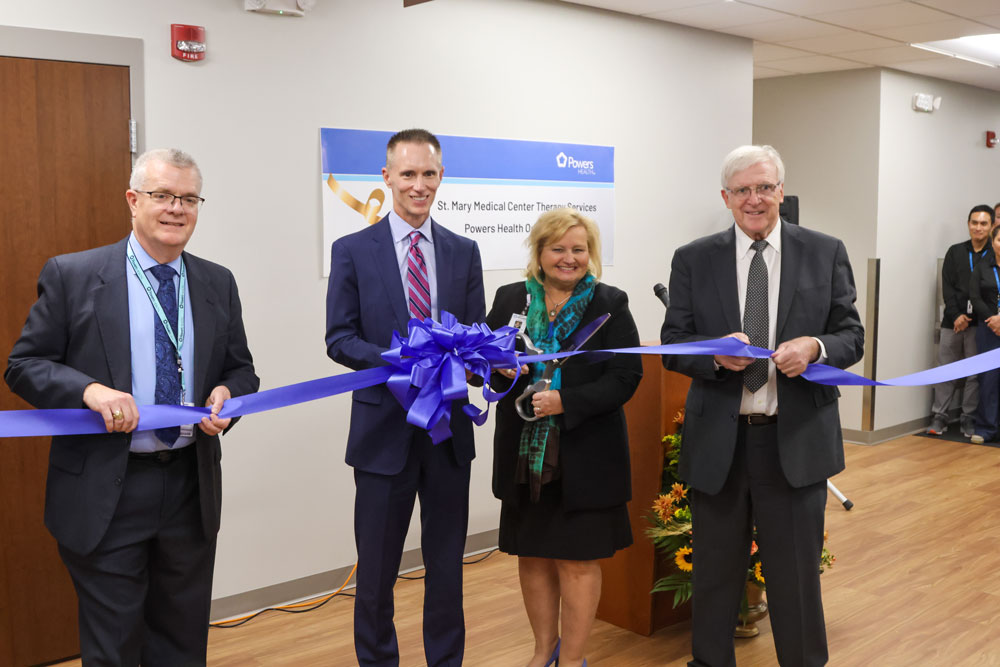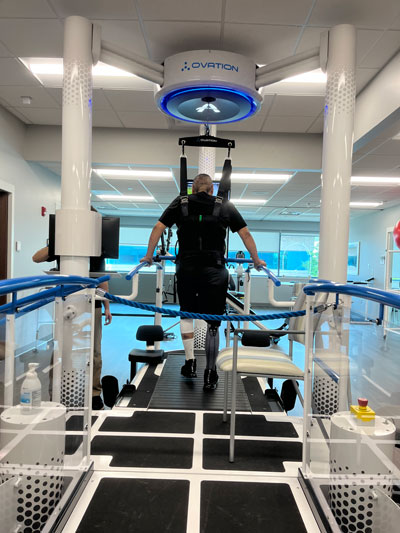

Finding freedom in ZeroG
Therapy equipment offers support, safety for patients
Secured in a harness that was tethered to a track on the ceiling gave Doug Bakker a feeling he longed for: freedom.
The 60-year-old Cedar Lake father of three had lost some of his freedom after complications following aortic valve replacement surgery at an Illinois hospital. He went into anaphylactic shock after receiving steady doses of a blood thinner to which he was unknowingly allergic. After emergency surgery for leg clots and a series of mini strokes, he ended up on a ventilator for three weeks.
In time, he came off the ventilator and went into rehabilitation. Once an avid fisherman, camper and kayaker, Bakker found himself struggling with basic movements like walking and balancing.
He underwent intense rehabilitation at an Illinois hospital, was transferred to a nursing home and eventually returned home. Home Health came to assist, but his wife Kris Bakker knew her husband needed more intense therapy.
“I wanted him to have the ZeroG,” she said. “I knew he needed it.”
She had worked as a physical therapy technician at St. Mary Medical Center in Hobart for four years and is familiar with rehabilitation therapies.
Doug Bakker turned to Community Healthcare System’s Community Stroke & Rehabilitation Center in Crown Point, where he trained with the ZeroG Gait and Balance System.
Mounted to an overhead track, the ZeroG supports patients and protects them from falls as they practice therapy exercises. ZeroG “un-weights” patients, meaning it offloads some of their body weight to make them feel lighter as they build strength and range of motion. The equipment assists with balancing, moving from sitting to standing, walking and stepping up and down stairs.
“I gained confidence the more I used it,” Doug Bakker said.
He trusted the equipment would support him.
“If you start to lose your balance, it catches you,” he said.
The confidence he gained while training with ZeroG during therapy sessions translated into self-assurance when using a cane or walker in other places, like at home, he said.
Physical Therapist Amy Huckstep said Bakker needed therapy two to three times per week at the beginning. The primary focus was to use ZeroG for gait training in a safe environment.
“Within a few months, he was able to achieve longer distances and eventually became stable enough to incorporate standing and walking at home,” Huckstep said.
Bakker also used the ZeroG for stair mobility training because he lives in a bi-level home, and the stairs were limiting his access to the full environment.
“Prior to the use of ZeroG, he was using a chair lift in his home for the stairs but is now able to navigate the stairs with minimal support from his family,” Huckstep said.
The ZeroG can accommodate patients up to 450 pounds and benefit those who live with certain conditions, including stroke, spinal cord injury, multiple sclerosis and traumatic brain injury.
Therapists purposely tried to trip him up so he could strengthen his ability to balance, Kris Bakker said.
Huckstep said ZeroG has a “trips function” so patients may practice reacting to unexpected obstacles to improve balance responses and to decrease the risk of falls.
Doug Bakker said he even walked backward in the security of the ZeroG harness.
In the throes of recovery, it can be difficult for a person to notice his own improvement. But a number of people have remarked to Bakker on how far he has come through the help of therapy.
“Hearing people tell me how good I’m doing … when you’re in it, you really don’t see the progression,” he said.
The team at Community Stroke & Rehabilitation Center noticed his progress, too.
“ZeroG played a vital role in Doug’s ability to resume functional ambulation,” Huckstep said. “With the capability to un-weight and prevent falls, the ZeroG provided Doug with the chance to greatly increase his repetition of walking practice. As a result, he was able to eventually restore his ability to walk in the home and community with supervision, and he is now participating in more of his previous functional activities.”
Bakker goes to therapy about once a week now. He and his wife have high praise for Huckstep.
“Amy has been amazing,” Kris Bakker said. “She is definitely an asset.”
Doug Bakker said the entire staff at Community Stroke & Rehabilitation Center have been supportive.
“I love everybody there,” he said. “They’re all great people. They’ve helped me move forward. I highly suggest going there.”


